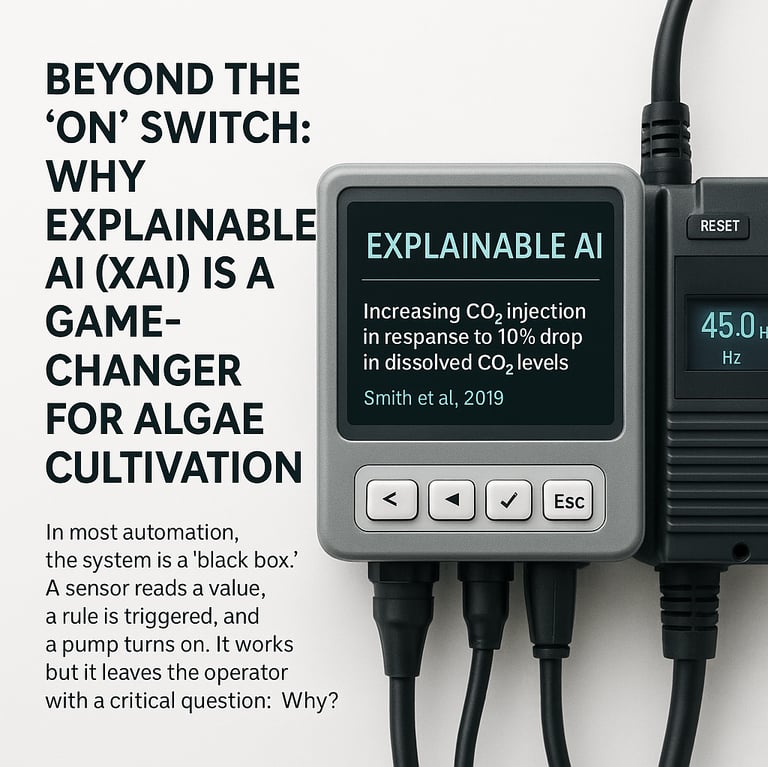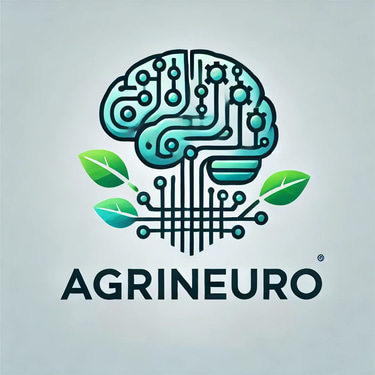Beyond the "On" Switch: Why Explainable AI (XAI) is a Game-Changer for Algae Cultivation
Our AI, trained on a specialized library of over 70,000 scientific research papers, doesn't just make a decision—it explains its reasoning.
When the system increases CO2 dosing, it won't just log "dosing activated." It will tell you: "Increasing CO2 injection in response to a 10% drop in dissolved CO2 levels, which correlates with peak photosynthetic activity observed in 'Chlorella vulgaris' at this light intensity and pH level (Source: Smith et al., 2019)."
When it adjusts mixer speed, it will explain: "Modifying VFD frequency to 45Hz to increase turbulence, improving CO2 dissolution efficiency as recommended by 'Bioreactor Dynamics Review, 2021'."
This approach transforms your facility from simply "automated" to truly "intelligent."
The benefits are immediate:
Trust: You can see the scientific basis for every action, giving you the confidence to let the system manage critical processes.
Insight: You and your team learn from the system, gaining a deeper understanding of your culture's specific needs.
Optimization: By linking actions to peer-reviewed science, our AI makes optimizations that go far beyond simple "if/then" rules, driving your system toward its maximum biological potential.
Automation is a tool. Explainable AI is a partner.


In most automation, the system is a "black box." A sensor reads a value, a rule is triggered, and a pump turns on. It works, but it leaves the operator with a critical question: Why?
This lack of transparency is a major barrier to true optimization. If you don't know why your automation is doing what it's doing, you can't fully trust it. You can't learn from it. And you can't be confident that its decisions are scientifically sound.
At Agrineuro, we are changing this. Our platform is built on a principle of Explainable AI (XAI), or what we call "Transparent Automation."
The CO2 Conundrum: Maximizing Biomass with Closed-Loop Hardware Control
In algae cultivation, carbon dioxide is the primary feedstock. It's also one of the most expensive and difficult-to-manage variables.
The common approach is often inefficient. Timer-based injection can waste vast amounts of CO2 by dosing when the algae can't use it, while simple "on/off" systems based on a pH threshold are crude and reactive. Both methods lead to a "feast or famine" cycle that stresses the culture and limits growth.
The key to maximizing biomass is not just dosing CO2, but ensuring its maximum dissolution and uptake. This requires a dynamic, closed-loop system that links sensors and hardware.
This is precisely what the Agrineuro platform is designed to do.
We Monitor: Our industrial-grade dissolved CO2 sensors provide a real-time, parts-per-million (PPM) measurement of the CO2 available to your algae.
We Control: This data is fed directly into our AI controller, which intelligently manages two key pieces of hardware:
Stepper Motors: For micro-liter precision, our system controls stepper motors for nutrient dosing and CO2 injection. This means no waste, no "dumping,"—just the exact amount required.
Variable Frequency Drives (VFDs): CO2 doesn't dissolve well on its own. Our AI controls the VFDs connected to your mixers or air pumps. It can increase mixing speed (turbulence) during a dosing event to improve dissolution, then ramp down to save energy once saturation is achieved.
This "sensor-to-hardware" feedback loop ensures your culture exists in a perfectly balanced environment. It gets exactly what it needs, precisely when it needs it, all while reducing your operational costs on energy and CO2 gas.
5 Years in 5 Minutes: Using Historical Data to Predict Seasonal Growth Trends
What if you could predict your July yield based on your last five summers? What if your automation system knew, based on past performance, that it needed to increase nutrient dosing in the second week of November to account for lower light levels?
In algae cultivation, "set it and forget it" doesn't work. Seasonal changes in ambient light and temperature have a massive impact on growth. A setpoint that works in June will crash your culture in January.
Most systems only look at the data from the last few hours. The Agrineuro platform looks at the last five years.
Our system is designed for long-term trend analysis. By securely logging all sensor and hardware data, we build a rich historical profile of your facility's unique performance. Our AI models then analyze this deep dataset to unlock powerful, predictive insights.
This allows you to move from reactive to predictive operations:
Predictive Biomass Forecasting: Our AI analyzes your current growth trajectory against historical seasonal trends to provide an accurate forecast of your biomass yield. This allows for superior planning of harvests, labor, and resource purchasing.
Proactive Automation: The system identifies subtle seasonal patterns and will proactively adjust automation parameters before a problem occurs. It learns that, for your specific facility, it needs to modify light cycles or nutrient profiles to keep growth optimal as the seasons change.
Performance Benchmarking: You can look back at any point in time and compare performance. "Why was Q3 2024 so much more productive than Q3 2025?" The data will have the answer, allowing you to replicate successes and eliminate failures.
Data is the most valuable asset your facility produces. We help you use it.
Contact Us
Reach out to explore how AI can enhance your farming efficiency and sustainability with Agrineuro.
Innovation
Transforming algae through AI-driven solutions.
Sustainability
Efficiency
© 2025. All rights reserved.
